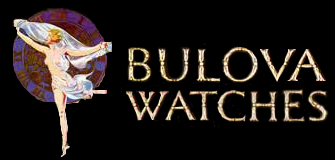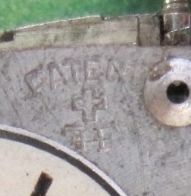I picked up this old pocket watch conversation just because I was curious about it, and I have some questions for you movement experts in the forum.
The dial looks like authentic old Bulova to me, and so does the movement, but the case is more recent and not Bulova, so I think we should just leave that out of the discussion for now. My question really has to do with a symbol on the movement.
The movement is a 10 A.I., 15 Jewels, 3 Adjustments, Swiss, serial no. 74417.
I cannot find a date code on the movement, despite much looking with strong magnification and bright light. I have one other watch with a 10 A.I. movement, and it also does not have a date code. I have dated that watch to 1921 based on the case serial number.
Any thoughts on what the symbol means, next to the word "Swiss" in the third pic below, and/or the who, what, when of the movement? Do I need to remove the dial and take a pic of the other side of the movement?
Ok, something a bit odd here. Bestfit lists the 10AI as being interchangeable with the 10A, 10AA, 10AAI, etc, all being the FHF cal 10 Robert. However, when I look at actual examples of these other Bulova calibres, the train bridge is different. The movt is similar enough to be the same, with a modified bridge, but the ID on these is under dial, so you will have to look under the dial. The picture above screams AS340, and that is what is throwing me here. I was not aware that the two companies had any merging of calibres going on this early in the game. Anyway, this is an issue that would only drive a watchmaker nuts, as it is splitting hairs.
This is a pendant style watch, and if the dial feet are still intact and fit the movt perfectly, my guess is that it is original. These movts were very common and were used by many companies besides Bulova. I have a box of several hundred of them, with dozens of extinct company names, and as they were used frequently in early wristwatches which soldiers readily adopted, after WWI they bear model names like "Vimy", and "Ypres", and "Courrier".
Anyway, your movt should have an ID under the dial, you will have to take off the hands, and half turn the screws holding the dial feet from the movt side, to release the dial. If there is no stamp, which sometimes happens, the keyless works 'fingerprint' will allow a positive ID. I notice we don't have a 10AI in the database, and neither does Doktor Ranfft, but he does show the AS 340 with its different bridges.
Does your example also have the backwardsF H backwardsF stamp (below cross on my photo) ?
You have date from SN. I'm curious at what point in time the FHF symbol appeared stamped w/ cross symbol. If the cross trademark was older than the FHF symbol trademark, the date which they both appear together could be the earliest possibility. I've got example bridges w/ these two symbols occurring together from the late 20's through 1932.
Rob will probably know off the top of his head.
In reply to Does your example also have by William Smith
The cross means Swiss. Sometimes the word patent is in French: Brevet, and sometimes it is further clarified by either deposeé, or dem., (short for demande) , meaning Swiss patented or patent pending. (applied for) FHF is, of course, Fabrique Horlogerie de Fontainemelon. The fact that there is no calibre or maker's mark isn't surprising. According to the keyless works, it is an FHF- Robert. The fact that the balance side looks like an AS 340 may mean there was some merging of these calibres, because AS and FHF and ST were stamped alternatively on some ebauches, but later in history. Despite who originally designed the movt, after ESA was formed, it was sometimes manufactured by different sub groups under the ESA, and would be identical, despite the apparently different company as maker. This is quite early on for this to be happening, I'm guessing mid to late 20's here. It's odd.
Edit: ok, it's not odd. I had to go back and check my dates. ESA was merged in 1926, and was up and running Jan.1, 1927. That means what we are seeing here makes perfect sense. The original three companies under the ESA umbrella were AS, (A.Schild) FHF, and AM. (Michel) Many others followed. Urs Schild was the man who founded Eterna in 1831, and it was his grandson Cesar who merged the companies. It is a convoluted history, and anyone who is interested can read it here:
http://www.watchtime.at/archive/wt_2006_06/WT_2006_06_243.pdf
The Bulova calibre helps to identify the movt, as it can be cross referenced to the ebauche Bulova was using, (usually Swiss) or if it was an in house Bulova movt. Bulova used Swiss ebauches and finished them at the factory in Switzerland, or later at the factory in the US. Bulova also made complete movts in the US. Otherwise, dials, escapements, and balances were sometimes added or modified either in Switzerland or in the US. Different makers marked the movts in different ways, and I have seen identical movts marked and unmarked, I think it depends on who was buying them, and whether they were ebauches or finished movts that were used without any mods. Bulova would use the first number to denote the size of the movt, roughly, in lignes. A lot of 20's movts show no makers mark, but they are usually easy to identify. As I was writing this, I lined up six AS 340's, just to compare markings, and only two had their maker's mark under the dial. In later years, maker's marks were under the balance. The identity of a movt can be ascertained in most cases, by the shape of the components in the keyless works, under the dial. This is like a fingerprint for movts, and is useful when there are no marks.
In reply to The Bulova calibre helps to by Reverend Rob
I'm leaning towards mid twenties. (1927?) I think this movt was first manufactured 1924-25, but I'm having trouble finding any references. Our database has several derivatives, 10A and 10AA, and I see the AI was used in 21-23. However, the 'bug-eyed' bridge on this particular example is more late twenties. How accurate are our production dates? Is it possible the movt in question was used longer than we think? The lack of an ebauche maker's mark, with the melding of two designs, the AS 340, and the FHF Robert, suggest that the movt dates to 1926-27, at the beginning of the ESA group. Earlier FHF Robert movts lack the bug eyed bridge of the AS 340. These are just my impressions, details on design integration, especially the dates, are hard to confirm, but Doc's pics of the 340 show the later bridge, and his example dates to 1930, although I am sure this watch is earlier.
Anyone got a Ouija board? We need to consult Joseph.

